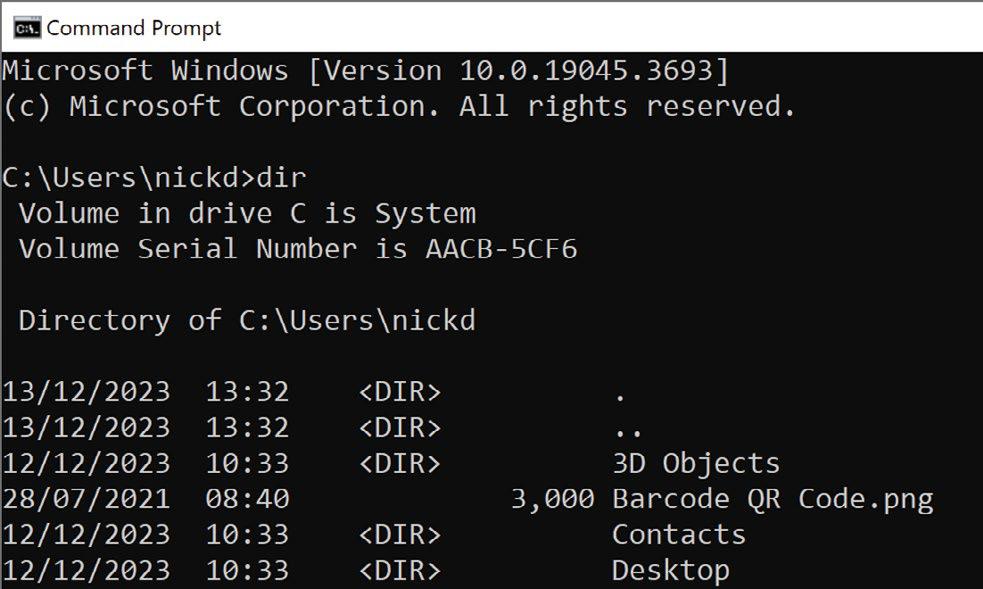
WHEN USING COMMAND PROMPT, have you ever needed to list the contents of a folder or drive? If so, then the DIR command has you covered. At first glance, that's all it can do-and in a less visually accessible way than File Explorer. But dig a little deeper, and you'll find ways in which DIR can play a more active role: use it to quickly perform file searches, generate file lists you can open and edit in any text editor, and even confirm that your precious files are safe when Windows refuses to load. Here, we'll explain how to use this powerful tool. Note that whenever we use yourname', you should replace it with your name as it's registered in your Users folder (it's 'nickd' in our screenshots). -NICK PEERS
1 LEARN THE BASICS OF DIR
Open Command Prompt (press Win+R, type cmd and press Enter) to find yourself in your personal user folder— for example, C:\Users\yourname. Type dir [ 1 ] [Image A] and press Enter. The command will first list the drive’s label if it has one—it’s ‘System’ in our example [2 ]. If there isn’t one, you’ll see ‘Volume in drive C has no label’. Below that will be an alphabetical list of the contents of your user folder.
» Information about each entry is split into five columns [3 ]: the first two show the date and time the file or folder was last modified—the same information that’s shown in File Explorer. » Next to this is a column that’s either marked <DIR> for a folder, or left blank for a file, followed by a column that lists file size in bytes. The final column displays the folder or file name. These figures are always displayed in bytes.
Esta historia es de la edición March 2024 de Maximum PC.
Comience su prueba gratuita de Magzter GOLD de 7 días para acceder a miles de historias premium seleccionadas y a más de 9,000 revistas y periódicos.
Ya eres suscriptor ? Conectar
Esta historia es de la edición March 2024 de Maximum PC.
Comience su prueba gratuita de Magzter GOLD de 7 días para acceder a miles de historias premium seleccionadas y a más de 9,000 revistas y periódicos.
Ya eres suscriptor? Conectar

Velocity Micro Raptor ES40
A compact PC that mixes it with the big boys

Intel Arc B580
Intel's second crack at the gaming GPU market

Indiana Jones and the Great Circle
Dr Jones will steal your heart in MachineGames' best effort to date

Improve your memory with Windows Recall
SINCE ITS ANNOUNCEMENT at Microsoft's Build conference in May 2024, Recall has had a torrid time.

HAVE WE REACHED MAXIMUM PC?
Has the desktop reached the point where it can get no better? Ian Evenden looks ahead

THE EVOLUTION OF VIDEO GAME AI
Over time, game AI has become more refined.

X (formerly Twitter) vs Bluesky
The battle of the micro-bloggers

Fun and graphics card games at CES 2025
WE ALL KNEW what was coming at CES: a bunch of graphics cards from AMD and Nvidia. They were pretty much exactly as predicted, albeit with some surprises. AMD managed to botch the launch of its RDNA 4 cards, while Nvidia played 3D chess with the pricing of its new RTX 50 cards.

AMD UNVEILS NEW GAMING AND AI CHIPS
AMD Ryzen AI Max series announced at CES 2025

DOCTOR
Save CCTV system | Multiple audio devices | Encrypted download